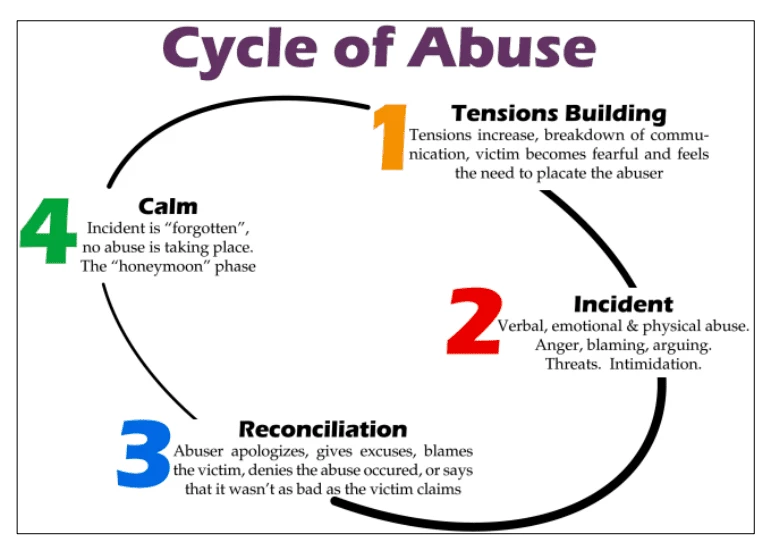Understanding the Cycle of Abuse

A Universal Pattern
The cycle of abuse typically comprises four stages
The cycle of abuse, traditionally associated with intimate partner relationships, is a pattern of behaviours that can manifest in various types of relationships, including those in workplaces, friendships, and educational settings. Understanding this cycle across different environments is crucial for recognising and addressing abusive behaviours.
Within the workplace, abusive behaviours in professional settings can include bullying, harassment, and exploitation of power dynamics. Such actions not only harm the targeted individual but also create a toxic work environment, leading to decreased morale and productivity.
Friendships can also develop abusive patterns. They may present as manipulation, coercion, or consistent undermining. A friend might exploit another's vulnerabilities, leading to feelings of worthlessness or dependency.
Abuse in schools or universities can involve bullying by peers or even educators. This includes verbal harassment, social exclusion, or academic sabotage, severely impacting a student's mental health and academic performance.
Experiencing abuse in any relationship can lead to a range of adverse effects, including anxiety, depression, diminished self-esteem, and even post-traumatic stress disorder (PTSD). In professional or academic contexts, this may result in decreased performance, increased absenteeism, and a higher likelihood of leaving the environment altogether.
Awareness is the first step toward intervention. Recognising the signs of the abuse cycle allows individuals and organisations to take proactive measures, such as implementing supportive policies, providing access to counselling services, and fostering open communication channels.
Understanding that the cycle of abuse is not confined to intimate relationships but can permeate various aspects of life is essential. By identifying and addressing these patterns across different environments, we can work towards healthier, more respectful interactions in all areas of society.
Tension Building. This initial phase involves increasing strain and stress between individuals. In non-intimate settings, such as workplaces or schools, this might manifest as escalating disagreements, subtle insults, or passive-aggressive behaviours.
Incident of Abuse. The tension culminates in an abusive incident. Beyond physical violence, abuse can take forms such as verbal attacks, psychological manipulation, or social sabotage. For instance, in a workplace, this could involve public humiliation or unwarranted criticism.
Reconciliation (Honeymoon Phase). Following the incident, the perpetrator may exhibit remorse, offer apologies, or make conciliatory gestures. In friendships, this might involve gifts or promises to change, aiming to repair the relationship without addressing the underlying issues.
Calm. The relationship temporarily returns to a semblance of normalcy. However, without proper intervention, the underlying issues remain unresolved, setting the stage for the cycle to repeat.
A First Step in Understanding
Abuse often follows a repetitive pattern known as the cycle of abuse. Picture it like a circle that keeps going around. Recognising and understanding this cycle is crucial for breaking free from its grip. The cycle typically consists of three phases: tension building, explosion, and reconciliation.
Tension Building
The first phase of the cycle is tension building. During this stage, tension starts accumulating between the people involved. It's like you can feel something’s not right, but you're unsure when it will blow up. Small signs like increased arguments or a sense of walking on eggshells may be evident.
Victim’s Responses
Attempting to calm the partner
Nurturing behaviour
Alternating between silence and excessive talking
Isolating from family and friends
Keeping children quiet
Agreeing with the abuser
Trying to reason
Cooking favorite dinners
Perpetrator’s Behaviour
Moodiness
Nitpicking
Withdrawing affection
Put-downs
Yelling
Substance abuse (drugs/alcohol)
Making threats
Destroying property
Criticism
Sullen behavior
Engaging in "crazy-making" behavior

Explosion
The tension reaches a boiling point and explodes into an intense moment. This is when the abusive behaviour occurs. It could involve yelling, hitting, or other harmful actions. Everything that was building up bursts out in a destructive manner.
Victim’s Responses
Protecting themselves and their children in any way possible
Calling the police (either by themselves, their children, or neighbours)
Trying to calm the perpetrator
Attempting to reason
Fighting back
Leaving the situation
Perpetrator’s Behaviour
Physical violence (hitting, choking)
Humiliation
Imprisonment
Rape
Use of weapons
Verbal abuse
Destroying property

Reconciliation
After the explosion, there's a phase where things might seem calm. The perpetrator might apologise, promise it won’t happen again, or try to make up for it. This is a brief period of peace, but unfortunately, it’s part of the cycle and not a genuine resolution.
Victim’s Responses
Agreeing to stay
Returning or accepting the perpetrator back
Attempting to stop legal proceedings
Setting up counselling appointments for the perpetrator
Feeling happy or hopeful
Perpetrator’s Behaviour
Apologising or begging for forgiveness
Promising to get counselling
Promising to get counselling
Sending flowers and presents
Vowing never to repeat the abuse
Expressing love and affection
Enlisting family support
Crying and showing remorse

Denial
Denial involves minimizing the abuse, acting as if it didn’t happen, or pretending it will never happen again. This perpetuates the cycle of violence, making it difficult to break free and find a path to healing.
Impact on Survivors
The emotional, physical, and psychological consequences of abuse on survivors are profound. Emotional impacts include anxiety, depression, and a sense of helplessness. Physically, survivors may endure injuries and long-term health issues. Psychologically, the abuse can lead to PTSD and other mental health disorders. Understanding these impacts is a crucial step in the healing.
Recognising and understanding the cycle of abuse is the first step towards breaking free and achieving empowerment and healing. This knowledge lays the foundation for recovery and building a brighter, safer future. By breaking down the cycle of abuse and understanding its phases, victims can begin to see the patterns and take steps to escape. The journey towards healing is challenging but crucial, and understanding the cycle of abuse is the first stride towards empowerment and a safer life.

Your life, Your choice. Free-Spirited Coach Jennifer Taylor here to help you gain the choices within life that you desire. Ready to break down society's pressures and find your own path? Let's do this!
Mental Health Advocate | Domestic Abuse Survivor | Exploring Human Behaviour & Wellbeing | Trauma Informed
Mental Health Advocate | Domestic Abuse Survivor | Exploring Human Behaviour & Wellbeing | Trauma Informed
coach[koh-ch] noun
A person dedicated to bringing the best out of you by encouraging, inspiring and believing.
info@jenntaylor.co.uk
www.jenntaylor.co.uk
078078 52292

